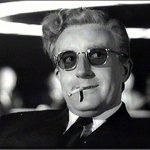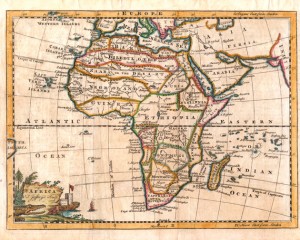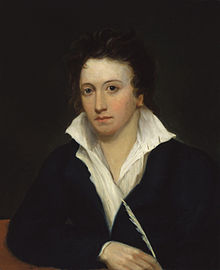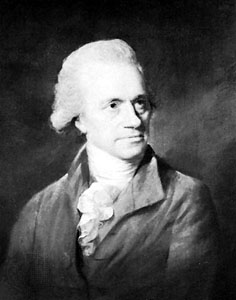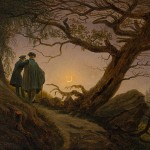
Caspar David Friedrich, “Two Men Contemplating the Moon,” ca. 1825-30. Oil on canvas. © The Metropolitan Museum of Art
Richard Holmes designates the “Romantic Age of Science” as The Age of Wonder, but what of wonder before the late eighteenth and early nineteenth centuries? For over two thousand years before Holmes’ “Romantic generation,” Pagan then Christian thinkers viewed wonder as the starting point of philosophy. Ancient through enlightenment-era natural philosophers underscored wonder as integral to the advancement of knowledge.Aristotle’s Metaphysics articulated the wonder to knowledge paradigm, or admiratio toscientia, as the result of human curiosity. For Aristotle, this natural “desire to know” and philosophize dated back to (and was in fact “owing to”) the earliest philosophers’ state of wonder. During the seventeenth and eighteenth centuries, this classical admiratio—scientiaparadigm served as the scientific mantra for, among other philosophers, Bacon, Descartes, Hobbes, Malebranche, and Vico. In The Age of Wonder Holmes elides these more contemporary views of wonder and curiosity as essential for the close attention necessary to advance knowledge and instead ties the classics with the romantics. He cites Plato by way of Coleridge and describes wonder’s effect on the passions and intellect by way of Wordsworth.
Holmes paints the Romantic Age of Science as the second scientific revolution (following Coleridge’s 1819 Philosophical Lectures), one that hearkens “a new vision” or “a new notion of a popular science, a people’s science” as opposed to “the scientific revolution of the late seventeenth century … an essentially private, elitist, specialist form of knowledge” (xix). Likewise, Holmes suggests a new vision of wonder. This Romantic wonder integrates eighteenth-century concepts of the sublime, as when the book’s subtitle, “How the Romantic Generation Discovered the Beauty and Terror of Science” unites the duality of wonder-provoked delight and dread. This wonder unites subjectivity and objectivity to inspire science, or knowledge, by impacting “the heart as well as the mind” (xx). But in fact, this “new” age of wonder reiterates ancient, early modern, modern, and postmodern perceptions of wonder.
The greatest novelty of Holmes’ “age of wonder” belongs to its redirect from religious awe. It is this secular wonder that inspires the “new” notion of popular science he describes as the second scientific revolution. Instead of citing Plato first by way of his student Aristotle and next by way of St. Thomas Aquinas, Holmes separates wonder from Christianity. The thirteenth-century Church Father, Aquinas evoked the opening words of Aristotle’s Metaphysics in order to underscore wonder’s pious usefulness (or utilitas). Effectively Christianizing Plato and Aristotle’s classic admiratio—scientia paradigm, Aquinas’ wonder lead souls to knowledge of God. Thus before Holmes’ second, popular and secular scientific revolution, wonder served both scientific and evangelical functions in human hearts and minds. For example, Catholic Jesuits evoked wonder (admiratio) to inspire knowledge of nature (scientia) as well as knowledge of the Author of all nature (Scientia). Scientific progress could serve “the greater glory of God” (following the Jesuit slogan ad majorem Dei gloriam) and increase human piety. This brand of Christian wonder helped distance impiety from curiosity and greatly benefitted the “first” scientific revolution. For example, Francis Bacon encouraged the contemplation of God’s works to produce knowledge and articulated the Christianized admiratio—scientiaparadigm when he evoked wonder as the “seed of knowledge.”
Although certainly more secular, Holmes’ nineteenth-century “age of wonder” depends on the early modern period of European Empires, when human revelation was allowed to round out that which was divinely revealed and the original warnings against vain, human curiosity by the Church were replaced by the very pious quests for knowledge that spawned that first Western “scientific revolution.” During the fifteenth to mid-eighteenth centuries, wonder and knowledge served Christianity. One of the greatest legacies of the Romantic Age which Holmes describes has been the separation of science and religion in both academic and popular discourses. Twenty-first century scientists shy away from extolling the role of wonder (admiratio) as an impetus for knowledge (scientia) that also encourages sacred awe toward the Christian God (Admiratio). Today science tries to resist being labeled superstitious as evolutionists debate creationists and “intelligent design” replaces the language of God as the primary cause of any secondary causes revealed by physics. Throughout all ages, however, wonder (admiratio) has inspired knowledge (scientia): both science to increase piety and science “for its own sake.”
